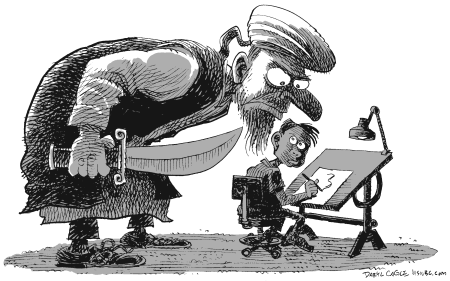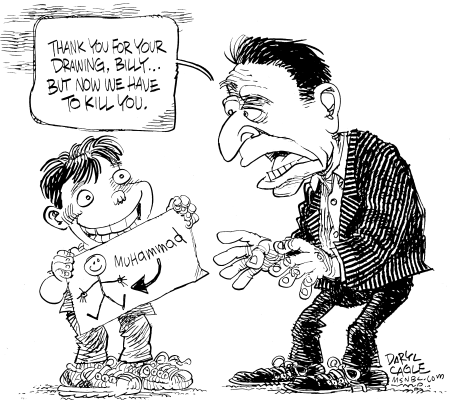The New York Times’ stupid decision to stop publishing editorial cartoons is generating more articles around the world, and the world’s cartoonists are responding with lots of cartoons on the topic – some of the cartoons are more offensive than Antonio Antunes’ cartoon, and I won’t show them here, but I’ve posted some new ones here.
Courrier International, the great French news magazine that reprints lots of editorial cartoons by international cartoonists, asked me a bunch of questions for an upcoming article; I thought I would post my responses here.
1) As a cartoonist and founder of Cagle Syndicate Cartoon, what do you think of the incriminated cartoon by Antonio Moreira Antunes?

I would have killed the cartoon if it came in to us. I can also see how the cartoon could have slipped through, without notice, since the cartoon didn’t feature an obvious, anti-Semitic, Der Stürmer cliché like depicting a Jew as a rat or spider.
The Antonio cartoon illustrates the trope that Jews manipulate the world’s non-Jews, with yarmulke-wearing Trump blindly following Jews, which are broadly indicated by the Star of David the Netanyahu-dog wears on his collar, rather than having the dog wear an Israeli flag which would indicate that Trump is led by Israel. When cartoonists mix anti-Israel and anti-Jewish metaphors, the cartoons should be killed. It isn’t about the dog, although the choice of a German Dachshund is provocative; the most common anti-Semitic cartoons depict Jews as Nazis.

When we get an anti-Semitic cartoon from one of our cartoonists, I email the cartoonist letting him know why we killed his cartoon, and usually the cartoonist will say, “OK, I get it.” Over time, our cartoonists have learned where we draw the red lines and it is less of a problem for us. Anti-Semitic cartoons are so common around the world that the cartoonists are usually unaware that their cartoons are offensive.
2) Did the decision made by the NYT surprise you (that is : did you see it coming?)? What’s your reaction?
The Times doesn’t run editorial cartoons in their USA edition and has a long history of being cartoon-unfriendly, so their decision to stop running cartoons in their international edition didn’t surprise me.

I was mostly surprised that the Times suddenly cut off their relationship with their partner, Cartoonarts International Syndicate, because of the poor decision of a Times editor. Cartoonarts is a family business that has worked with the Times for nearly twenty years, with the Times handling all of Cartoonarts’ sales and online delivery services, which were suddenly cut off. The announcement that the Times would “stop using syndicated cartoons” didn’t describe how brutal their reaction was to a small business that relied on their long-running partnership and support from the Times.

3) Many cartoonists (Chapatte and Kroll, among others) reacted to the NYT’s decision saying : it is a bad time for cartoons, caricature, humor and derision. Do you agree with this appreciation?
Yes, jobs with newspapers are mostly a thing of the past for editorial cartoonists. Outrage is easy to express on the internet and often takes the form of demands for revenge on the publication and the cartoonist who offended the reader. Newspapers are responsive to organized online outrage and shy away from controversy. Cartoons draw more response from readers than words, and responses are usually negative as people who agree with the cartoons are not motivated to email the newspaper.

When did things begin to turn ugly, and why?
Editorial cartoonists are in the same, sinking boat as all journalists. Things turned ugly when the internet took the advertising revenue away from print.
Is there a US specificity in this context, especially since Donald Trump was elected president?
Not regarding Donald Trump. I’ve drawn Trump as a dog, and I’ve drawn Netanyahu as a dog. Cartoonists love to draw politicians as dogs. Anti-Semitic cartoons are common around the world but are not common in the USA where editors do a good job of recognizing and killing offensive cartoons.

4) Why is it important to defend cartoonists and press cartoons, according to you? (or: do you think a world without cartoons and caricature has become a serious eventuality? Can you imagine such a world?) What should be done to defend this form of journalistic expression?
5) As a cartoonist and founder of Cagle Syndicate Cartoon, what would you say about the role played by social medias? Do you see them rather as a useful tool or a threat to a good and sound public debate? Or somewhere in between?
It is troubling that so many people get their news through social media. Social media has taken the advertising revenue away from traditional news media – both online and in print – so journalism is being starved. Editorial cartoonists are no different than other journalists; we’re underpaid freelancers now; we draw for love rather than because of any good business sense.

I run an editorial cartoons site for readers at Cagle.com, and we stopped running advertising on the site. We rely on donations from readers to support Cagle.com. Other publications are going non-profit and relying on donations to support their journalism – I’m impressed with Pro-Publica and the Texas Tribune. The Guardian has been successful with support from their readers.
Cartoon fans who worry about our profession can support us by going to Cagle.com/Heroes and making a small contribution. We really appreciate everyone’s support!


Want to see more of my posts about the New York Times’ ugly, recent history with editorial cartoons?
Visit:
2012, The New York Times Cartoon Kerfuffle, Part 1
2012, The New York Times Cartoon Kerfuffle, Part 2
2007, The New York Times and Cartoons
2015, The New York Times, a Student Contest and Editorial Cartoons




















